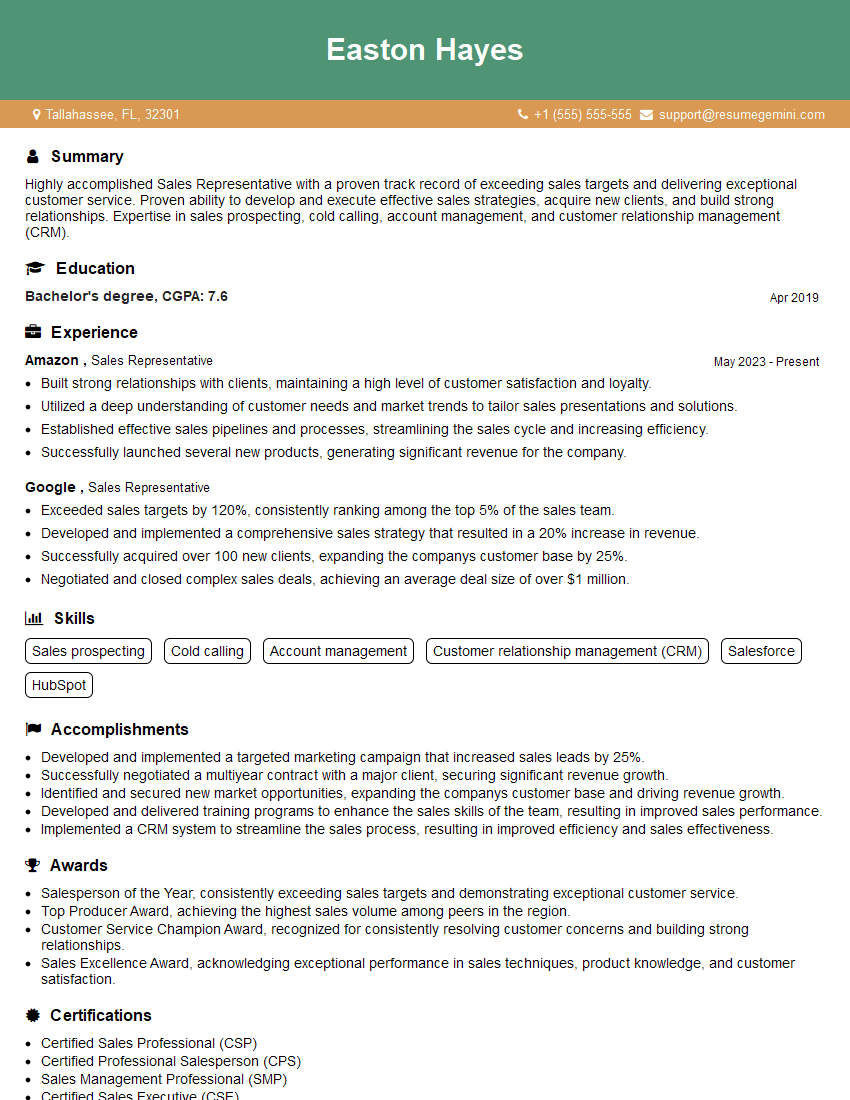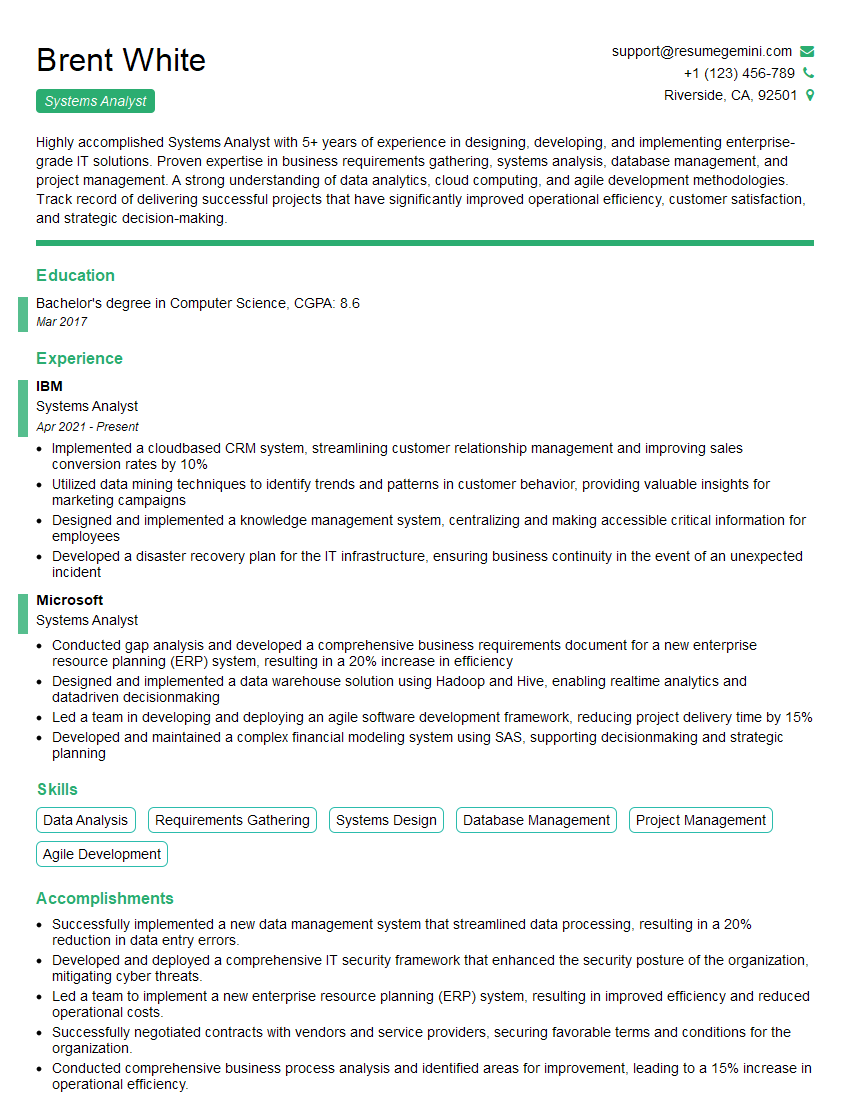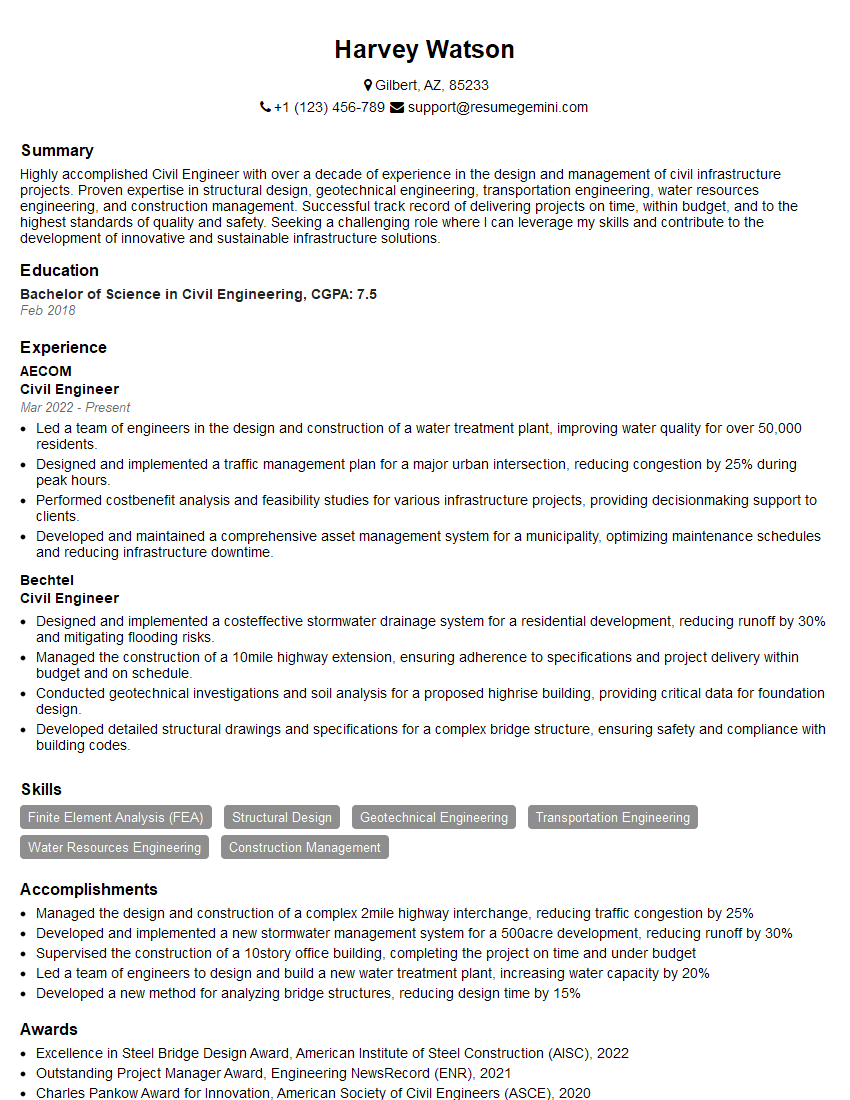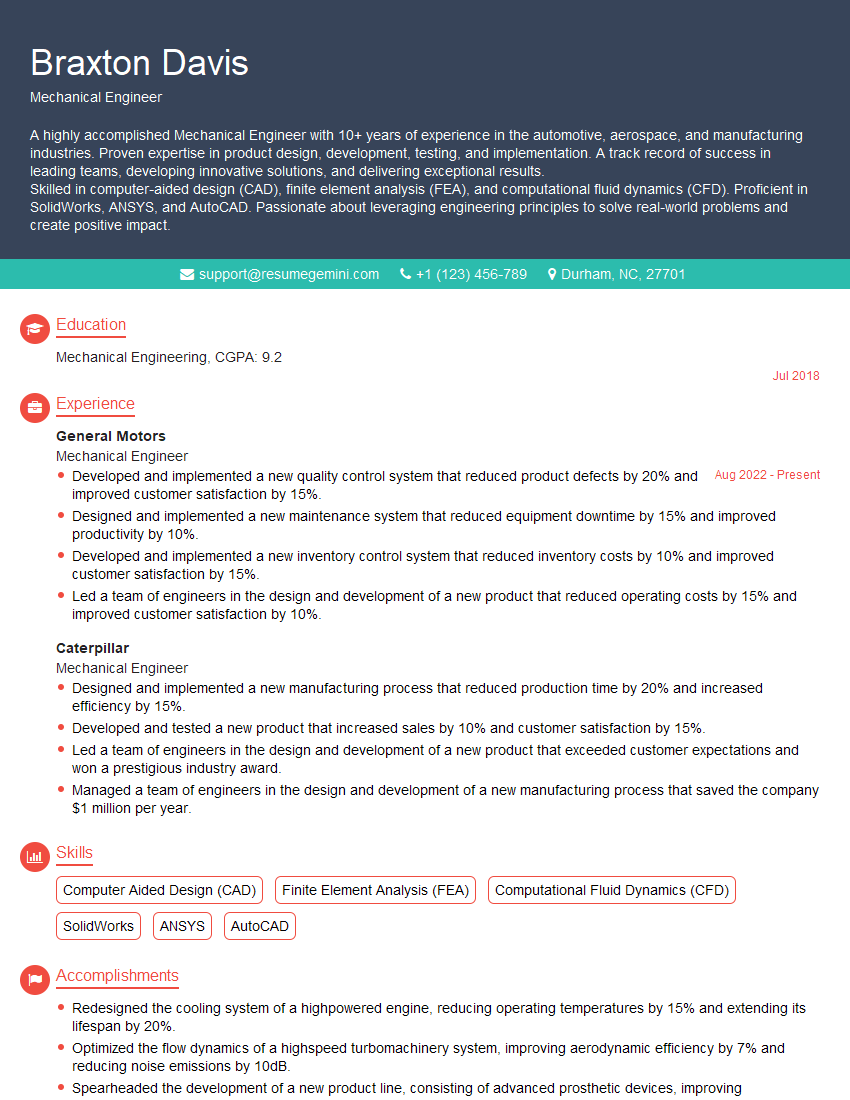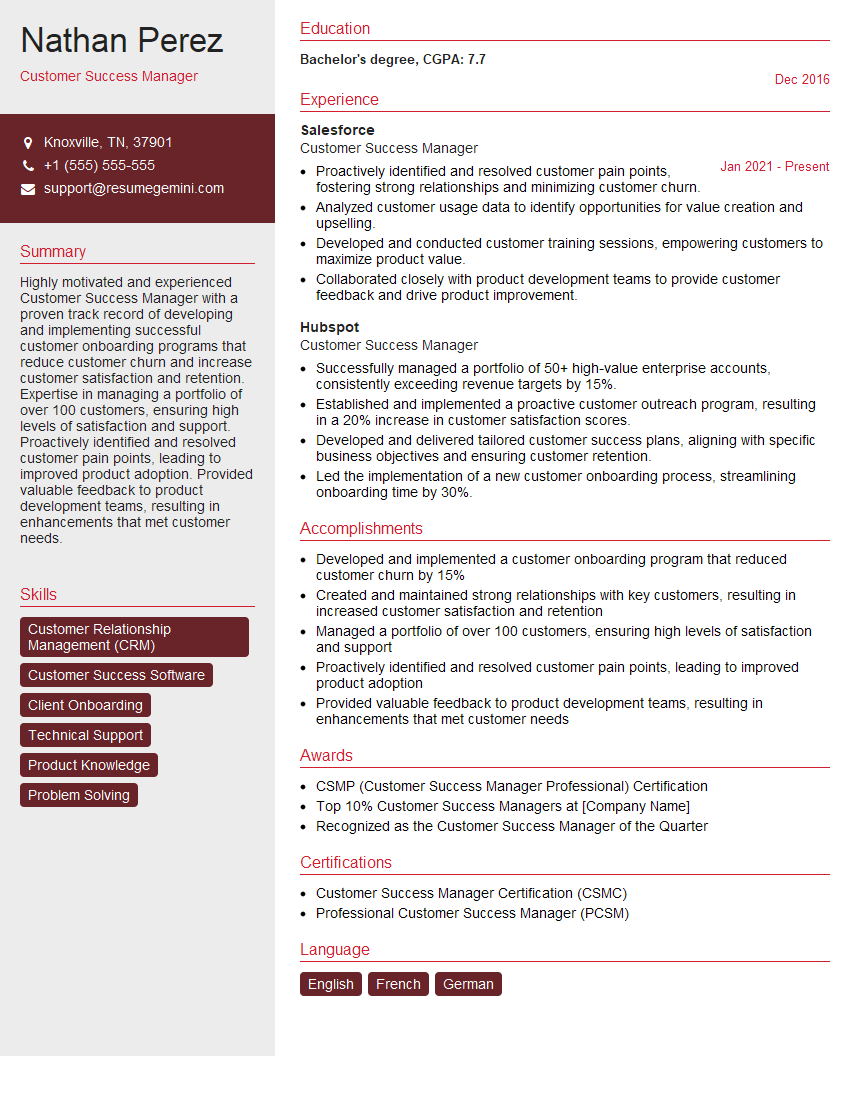Are you ready to stand out in your next interview? Understanding and preparing for Proficient in working in a team environment interview questions is a game-changer. In this blog, we’ve compiled key questions and expert advice to help you showcase your skills with confidence and precision. Let’s get started on your journey to acing the interview.
Questions Asked in Proficient in working in a team environment Interview
Q 1. Describe a time you had to resolve a conflict within a team.
During a critical project deadline, two team members, let’s call them Alex and Ben, clashed over the best approach to a specific module. Alex advocated for a more agile, iterative method, while Ben preferred a more structured, waterfall approach. The conflict initially manifested as raised voices and a standstill in progress.
To resolve this, I initiated a structured meeting. I first acknowledged both viewpoints, emphasizing the value of each approach. Then, I guided a discussion focusing on the project’s specific constraints and objectives. We created a hybrid approach, combining elements of both methods that addressed each team member’s concerns and best leveraged the project’s needs. The result was a compromise that satisfied both Alex and Ben, fostering stronger collaboration and leading to successful project completion on time.
Q 2. How do you handle disagreements with team members?
Disagreements are inevitable in a team setting. My approach is always rooted in respectful communication and a focus on finding a solution that benefits the team as a whole. I begin by actively listening to understand each individual’s perspective, asking clarifying questions to ensure I grasp their reasoning. I then focus on the core issue rather than the personalities involved. Once the issue is clearly defined, we brainstorm potential solutions collaboratively. If consensus can’t be reached immediately, I suggest a structured decision-making process such as voting or reaching a compromise. The key is to ensure everyone feels heard and that the final decision considers all perspectives.
Q 3. Explain your preferred method for delegating tasks within a team.
My delegation strategy is based on a combination of understanding individual strengths, aligning tasks with skills, and fostering ownership. I begin by clearly defining the task, its objectives, and deadlines. Then, I assess each team member’s skills and experience, matching tasks to individual capabilities and areas of interest. This not only maximizes efficiency, but also increases team members’ engagement and job satisfaction. Finally, I provide sufficient guidance and resources but also encourage autonomy and initiative. Regular check-ins and open communication ensure everyone remains on track and any challenges are addressed proactively. For example, in a recent project, I assigned data analysis to a team member skilled in statistics, design tasks to the team member with a design background, and writing to someone with strong communication skills.
Q 4. Describe a situation where you had to adapt your work style to fit a team’s needs.
On a project involving a remote team, I initially relied heavily on detailed email communication and structured project management tools. However, I noticed the team felt disconnected and communication was becoming inefficient. To adapt, I incorporated daily short video calls to foster a more spontaneous, collaborative environment. I also adjusted my communication style to be more conversational and less formal. This shift drastically improved team morale and communication effectiveness. The project progressed smoothly, demonstrating the importance of adapting my work style to meet the unique needs of the team.
Q 5. How do you contribute to a positive team environment?
I believe in fostering a positive team environment through several key actions. Firstly, I prioritize open and honest communication, encouraging constructive feedback and active listening. I also celebrate successes and acknowledge individual contributions to reinforce a sense of shared accomplishment. I strive to create a psychologically safe space where team members feel comfortable expressing their ideas and concerns without fear of judgment. Finally, I lead by example, demonstrating professionalism, respect, and a positive attitude. Small gestures, like recognizing birthdays or offering support during challenging times, can significantly contribute to a positive and supportive team dynamic.
Q 6. Give an example of a time you successfully collaborated with a diverse team.
In a recent project involving a geographically diverse team (members from the US, India, and the UK), we developed a new software application. The diverse backgrounds of team members brought a wealth of perspectives and experiences. To ensure effective collaboration, we established clear communication protocols, utilizing project management software and scheduling regular video calls at times convenient for all time zones. We leveraged each team member’s unique expertise – for example, the US team focused on design, the Indian team on development, and the UK team on testing. Clear roles, regular communication, and respect for cultural differences led to successful product development and a strengthened team bond.
Q 7. How do you ensure everyone on your team feels heard and valued?
Ensuring every team member feels heard and valued is paramount. I achieve this through several practices. Firstly, I dedicate specific time during meetings for open discussion and feedback. I employ active listening techniques, ensuring I understand each person’s viewpoint before responding. I also use various communication channels—such as email, instant messaging, and one-on-one meetings—to cater to individual communication preferences. Regular feedback sessions, both formal and informal, provide opportunities for acknowledgment and constructive criticism. Celebrating individual and team accomplishments reinforces a sense of belonging and value. By creating a culture of respect and inclusivity, I aim to ensure that every team member’s voice is not only heard, but genuinely valued.
Q 8. Describe your approach to providing constructive feedback to teammates.
Constructive feedback is crucial for team growth. My approach focuses on being specific, timely, and solution-oriented. I avoid generalizations and personal attacks, instead focusing on observable behaviors and their impact. I structure my feedback using the SBI (Situation-Behavior-Impact) model. For example, I might say: “Situation: During yesterday’s presentation, Behavior: you interrupted colleagues several times. Impact: This made it difficult for others to contribute their thoughts and led to some confusion.”
I then follow up with suggestions for improvement, focusing on what can be done differently next time. I always ensure a safe and respectful environment for receiving and giving feedback, making sure to acknowledge the individual’s efforts and positive contributions before addressing areas for improvement. I believe in active listening and understanding their perspective before offering solutions. Finally, I end by focusing on the future and how we can collaboratively improve. Open dialogue and mutual respect are key to making this approach effective.
Q 9. How do you manage your time effectively when working on a team project?
Effective time management in a team project relies on several strategies. First, clear task allocation and individual responsibility is paramount. We use project management tools like Jira or Trello to assign tasks, set deadlines, and track progress. Second, we have regular team meetings (daily stand-ups, weekly progress meetings) to assess progress, identify potential roadblocks, and redistribute workload as needed. Third, I prioritize tasks based on urgency and importance using a matrix; this helps to ensure that the most critical tasks are addressed first. Timeboxing—allocating a specific amount of time to each task—also prevents me from getting bogged down in less important details. Lastly, I utilize time management techniques like the Pomodoro Technique to maintain focus and prevent burnout. This involves working in focused bursts with short breaks in between.
Q 10. Explain a time you had to depend on a team member’s expertise to complete a task.
During a recent software development project, we encountered a complex database optimization problem. While I had experience with database design, my colleague, Sarah, had significantly more expertise in performance tuning and query optimization. We were facing a severe performance bottleneck that threatened our project deadline. I recognized my limitations and proactively sought Sarah’s help. We collaborated closely, with Sarah guiding me through the process of analyzing query execution plans, identifying inefficient queries, and implementing indexing strategies. Her expertise was instrumental in resolving the issue and ensuring the project was completed on time and within budget. This experience reinforced the importance of teamwork and leveraging the diverse skills within a team to overcome challenges.
Q 11. Describe your experience with different team communication styles and tools.
I’ve worked with a variety of team communication styles and tools. I’ve experienced teams that favor highly structured communication through detailed email chains and project management software, and others that rely more heavily on informal communication such as instant messaging or quick, regular meetings. I find that the most effective teams use a blended approach, choosing the right tool for the right purpose. For instance, we’ve successfully used tools like Slack for quick questions and updates, email for formal announcements and documentation, and video conferencing tools like Zoom for meetings and presentations. My adaptability allows me to effectively communicate and collaborate regardless of the team’s preferred style or the tools they use.
Q 12. How do you stay organized and track progress when collaborating on a project?
Staying organized and tracking progress is vital in team projects. We typically utilize a combination of techniques. First, we use a project management tool (like Asana or Trello) to create a central repository for all project documents, tasks, and deadlines. Each team member has clearly defined roles and responsibilities. Second, we establish clear communication channels to ensure everyone is informed of the project’s status. Third, regular status meetings help track progress against milestones. These meetings are not only for reporting but also for collaborative problem-solving and adjusting the project plan as needed. Fourth, we maintain a detailed project log to record decisions, issues, and resolutions, ensuring accountability and transparency.
Q 13. How do you handle a situation where a team member is not pulling their weight?
Addressing a team member who isn’t pulling their weight requires a sensitive but firm approach. First, I’d try to understand the underlying reason for the lack of contribution. Is there a personal issue? Do they lack clarity on their tasks? Are they overwhelmed? A private conversation to explore these possibilities is essential. I’d then work collaboratively to redefine tasks, offer support, or suggest time-management strategies. If the problem persists after these initial steps, I would escalate the issue to the project manager or team lead, providing documentation of the attempts to resolve the issue. My focus is on supporting the team member while upholding the team’s overall productivity and project goals. It’s crucial to maintain a constructive and supportive approach while establishing clear expectations.
Q 14. Explain how you measure the success of a team project.
Measuring the success of a team project involves considering multiple factors beyond simply meeting deadlines. We define success through a balanced scorecard approach. This means evaluating the project against pre-defined criteria across several key areas, including:
- Meeting deadlines and budget: Did the project deliver on time and within the allocated budget?
- Achieving project goals: Did the project achieve its intended outcomes and objectives?
- Quality of deliverables: Was the final product or service of high quality, meeting the required standards?
- Team satisfaction: Did team members feel valued, supported, and engaged throughout the project? We often use surveys to gather feedback.
- Client satisfaction (if applicable): Were the client’s needs met, and were they satisfied with the final outcome?
Q 15. Describe a time you had to motivate a team member who was struggling.
Motivating a struggling team member requires empathy, understanding, and a tailored approach. It’s not a one-size-fits-all solution; you need to identify the root cause of their struggles.
For example, I once worked with a junior developer who was overwhelmed by a complex project. Initially, they were producing subpar code and seemed disheartened. Instead of directly criticizing their work, I scheduled a one-on-one meeting. Through active listening, I discovered they lacked confidence in their abilities and weren’t fully grasping certain concepts.
My approach involved breaking down the project into smaller, more manageable tasks. I provided additional training and resources on the specific areas they were struggling with, offering regular check-ins and constructive feedback. I also paired them with a senior developer who could offer guidance and support. We celebrated small wins along the way to build their confidence. The result? They successfully completed the project, significantly improving their skills and self-esteem.
In short, effective motivation involves identifying the problem (lack of confidence, lack of skills, unclear expectations, etc.), providing the necessary support and resources, offering constructive feedback, and celebrating successes along the way.
Career Expert Tips:
- Ace those interviews! Prepare effectively by reviewing the Top 50 Most Common Interview Questions on ResumeGemini.
- Navigate your job search with confidence! Explore a wide range of Career Tips on ResumeGemini. Learn about common challenges and recommendations to overcome them.
- Craft the perfect resume! Master the Art of Resume Writing with ResumeGemini’s guide. Showcase your unique qualifications and achievements effectively.
- Don’t miss out on holiday savings! Build your dream resume with ResumeGemini’s ATS optimized templates.
Q 16. How do you handle pressure and deadlines when working collaboratively?
Handling pressure and deadlines collaboratively hinges on effective communication, proactive planning, and a shared understanding of priorities. When working on a project with tight deadlines, I advocate for a highly organized approach.
First, we establish clear expectations and roles from the outset. We use project management tools like Jira or Trello to track progress, assign tasks, and monitor deadlines. Regular stand-up meetings help maintain transparency and identify potential roadblocks early on. If a team member is struggling to meet their deadline, we address it immediately, offering support and reassigning tasks if necessary. This ensures that the project remains on schedule.
For example, during a particularly demanding project, we utilized the Kanban methodology. This visual representation of the workflow enabled everyone to understand the project’s status at a glance, making it easier to prioritize tasks and identify bottlenecks. This approach helped us navigate the pressure, meet the deadline, and deliver high-quality results.
Q 17. How do you adapt to changes in team dynamics or project scope?
Adaptability is crucial in team environments. Changes in team dynamics or project scope are inevitable. To effectively adapt, I prioritize open communication and a flexible mindset.
When faced with changes, I initiate a team meeting to discuss the implications of the change and how it affects individual roles and responsibilities. I encourage team members to openly share their concerns and suggestions. We then collaboratively redefine goals, adjust timelines, and reassess task assignments, ensuring everyone understands the updated plan.
For instance, during a project, we experienced a significant scope change halfway through. Instead of panicking, we held a team meeting to analyze the change impact. We prioritized tasks based on the new requirements, adjusted deadlines, and redefined roles. Through clear communication and collaborative problem-solving, we smoothly navigated the changes and successfully delivered the revised project.
Q 18. Describe your preferred methods for brainstorming and problem-solving within a team.
I believe in a multi-faceted approach to brainstorming and problem-solving. I find that a combination of structured and unstructured methods yields the best results.
We often begin with a brainstorming session using a mind-mapping technique to generate a wide range of ideas. This helps uncover innovative solutions we might not have considered otherwise. Following this free-flowing phase, we employ more structured methods, such as the ‘5 Whys’ technique to delve deeper into the root causes of a problem. We might also use a SWOT analysis to assess the strengths, weaknesses, opportunities, and threats associated with different solutions.
Finally, we prioritize the ideas based on feasibility, impact, and alignment with project goals. I encourage active listening and respectful debate during the entire process, ensuring every team member feels heard and valued. This collaborative approach fosters a sense of ownership and commitment.
Q 19. How do you ensure that all team members are on the same page regarding project goals?
Ensuring everyone is on the same page regarding project goals involves clear communication and documentation.
At the start of any project, we create a comprehensive project charter that outlines the project goals, objectives, deliverables, timelines, and key performance indicators (KPIs). This document serves as a central reference point for the entire team. We also hold regular team meetings, both formal and informal, to discuss progress, address concerns, and reaffirm the shared vision.
I also leverage project management software to track progress and ensure everyone is aware of their tasks and deadlines. Using visual aids like Gantt charts or Kanban boards helps provide a clear overview of the project status and enhances collaboration. Furthermore, documenting decisions and assigning responsibilities ensures accountability and clarity.
Q 20. How do you facilitate effective communication and information sharing within a team?
Effective communication and information sharing are paramount in team success. I encourage a culture of open communication and transparency.
We use a multi-channel approach, combining regular team meetings, instant messaging tools like Slack, and project management software. We schedule regular stand-up meetings to provide brief updates on individual progress and identify any roadblocks. Slack allows for quick communication and facilitates the sharing of documents and updates. Project management tools provide a centralized location for all project-related information.
Beyond these tools, I encourage active listening and clear, concise communication. I make sure to provide regular feedback and encourage team members to do the same. I also foster an environment where everyone feels comfortable asking questions and seeking clarification, ensuring that everyone is fully informed.
Q 21. Explain how you would handle a situation where a team member’s work does not meet quality standards.
Addressing subpar work requires a delicate balance of constructive feedback and support. It’s crucial to avoid blame and focus on improvement.
My approach involves a private conversation with the team member. I begin by expressing my appreciation for their efforts and then calmly and objectively point out the specific areas where their work falls short of expectations, providing specific examples. I avoid generalizations and focus on factual observations. Together, we identify the root causes of the issue—are they lacking necessary skills, struggling with a specific task, or facing personal challenges?
Based on the root cause, we develop an action plan. This might involve additional training, mentoring, adjusting workload, or providing more resources. I provide ongoing support and regular check-ins to monitor progress and ensure they are on track. The goal is not to punish but to help the team member improve and meet the required standards.
Q 22. How do you contribute to team decision-making processes?
My approach to team decision-making emphasizes collaboration and informed choices. I believe in fostering an environment where everyone feels comfortable sharing their ideas and perspectives. I actively participate by:
- Sharing my expertise: I contribute my knowledge and experience to the discussion, offering data-driven insights and potential solutions.
- Actively listening: I listen attentively to understand different viewpoints and identify potential areas of conflict or misunderstanding.
- Facilitating discussion: I help guide the conversation, ensuring that all voices are heard and that the discussion stays focused and productive. This might involve summarizing key points or gently redirecting the conversation if it strays off-topic.
- Seeking consensus: I aim to find solutions that are acceptable to the majority of the team members, while being mindful of minority opinions and concerns.
- Documenting decisions: Once a decision is made, I ensure it’s clearly documented, along with the rationale behind it, to maintain transparency and accountability.
For example, in a recent project where we needed to choose a new software platform, I facilitated a structured discussion, presenting the pros and cons of each option based on research and team feedback. This collaborative approach led to a well-informed decision that the entire team supported.
Q 23. Describe your experience with Agile or other collaborative project management methodologies.
I have extensive experience with Agile methodologies, particularly Scrum and Kanban. In my previous role, we utilized Scrum for a large-scale software development project. My responsibilities included:
- Participating in sprint planning: Defining user stories, estimating effort, and committing to tasks.
- Daily stand-ups: Reporting progress, identifying roadblocks, and collaborating with team members to address issues.
- Sprint reviews: Demonstrating completed work to stakeholders and gathering feedback.
- Sprint retrospectives: Participating in discussions to identify areas for improvement in our processes.
The Agile framework improved our team’s efficiency and responsiveness by promoting iterative development, continuous feedback, and adaptability to changing requirements. For instance, using Kanban boards helped visualize our workflow, identify bottlenecks, and improve our overall project management.
Q 24. How do you identify and address individual team member strengths and weaknesses?
Identifying and addressing team member strengths and weaknesses requires careful observation, open communication, and a supportive approach. I utilize a combination of techniques:
- Observation and feedback: I carefully observe each team member’s work, identifying their areas of expertise and where they might need additional support or training.
- One-on-one meetings: Regular individual meetings allow for open and honest conversations about performance, providing constructive feedback and opportunities for growth.
- 360-degree feedback: Where applicable, I facilitate 360-degree feedback processes to gain a comprehensive understanding of each team member’s contributions and areas for improvement from multiple perspectives.
- Mentoring and coaching: I offer guidance and support to team members, helping them develop new skills and overcome challenges. This might involve pairing them with experienced colleagues or providing access to relevant training resources.
- Delegation: I strategically delegate tasks based on individual strengths, ensuring that each team member is challenged and engaged in work that aligns with their capabilities.
For example, I noticed one team member struggled with technical documentation. Through one-on-one mentoring and providing access to online courses, I helped them improve this skill, boosting their confidence and contributing to improved project deliverables.
Q 25. How do you build rapport and trust with your team members?
Building rapport and trust involves fostering open communication, demonstrating empathy, and consistently acting with integrity. I achieve this by:
- Open communication: I encourage open dialogue, making myself approachable and creating a safe space for team members to share their thoughts and concerns.
- Active listening: I actively listen to understand perspectives, showing genuine interest in what others have to say.
- Respectful interactions: I treat each team member with respect and value their contributions, regardless of their seniority or background.
- Collaboration and mutual support: I participate actively in team activities and offer support to my colleagues whenever needed, fostering a sense of camaraderie.
- Transparency and honesty: I maintain transparency in my actions and communication, ensuring that team members are kept informed and updated.
Building trust takes time, but consistent effort and genuine interactions are key. For instance, celebrating team successes together and openly acknowledging individual contributions fosters a positive team dynamic.
Q 26. Explain your understanding of different team roles and responsibilities.
Understanding team roles and responsibilities is crucial for effective collaboration. Different projects require different structures, but generally, I recognize the importance of roles such as:
- Project Manager: Oversees the project’s scope, timeline, and budget, ensuring tasks are completed on time and within budget.
- Technical Lead: Guides the technical aspects of the project, providing expertise and mentorship to the development team.
- Developers/Engineers: Responsible for designing, developing, and testing the project’s technical components.
- Testers/QA: Responsible for ensuring the quality of the project’s deliverables through rigorous testing.
- UI/UX Designers: Focus on the user experience and interface, creating intuitive and visually appealing designs.
The specific roles and responsibilities will vary depending on the project’s nature and complexity. It’s essential to clearly define each role’s scope, ensuring no overlap or gaps in accountability.
Q 27. Describe your experience with remote team collaboration.
I have significant experience working with remote teams, leveraging various tools and strategies to ensure effective collaboration. My experience includes:
- Utilizing communication platforms: Employing tools like Slack, Microsoft Teams, or Zoom for seamless communication and real-time collaboration.
- Asynchronous communication: Utilizing email, project management software (e.g., Jira, Asana) for tasks that don’t require immediate responses, promoting flexibility for team members in different time zones.
- Regular virtual meetings: Scheduling regular virtual meetings to maintain team cohesion, share updates, and address any arising issues.
- Document sharing and version control: Utilizing cloud-based document sharing platforms (e.g., Google Drive, SharePoint) and version control systems (e.g., Git) to facilitate collaborative work on shared documents and code.
- Building trust and rapport virtually: Actively engaging in virtual team-building activities and ensuring open communication to foster a strong sense of team unity, despite physical distance.
In a recent project, we successfully managed a distributed team across three continents by using a combination of these tools and strategies. Regular check-ins and virtual social events helped us maintain a strong team connection.
Q 28. How do you ensure that all team members understand their roles and responsibilities in a project?
Ensuring all team members understand their roles and responsibilities requires clear communication, comprehensive documentation, and ongoing reinforcement. My approach includes:
- Clearly defined roles and responsibilities: Creating detailed role descriptions that outline specific tasks, responsibilities, and reporting lines for each team member.
- Project kickoff meetings: Conducting thorough kickoff meetings to discuss project goals, timelines, and individual roles and responsibilities.
- Regular check-ins and updates: Conducting regular meetings to track progress, address concerns, and ensure everyone is on track.
- Utilizing project management software: Utilizing project management tools to assign tasks, track progress, and facilitate communication among team members.
- Open communication channels: Establishing clear communication channels (e.g., dedicated Slack channels, email threads) for each team member to easily ask questions and receive prompt responses.
- Training and support: Providing necessary training and support to ensure each team member has the knowledge and skills to perform their roles effectively.
For instance, using a RACI matrix (Responsible, Accountable, Consulted, Informed) clarifies ownership and participation for each task, minimizing confusion and promoting accountability.
Key Topics to Learn for “Proficient in Working in a Team Environment” Interview
- Collaboration & Communication: Understanding different communication styles, active listening skills, effective feedback delivery and reception, and conflict resolution techniques. Consider how you’ve navigated disagreements constructively within a team.
- Team Roles & Dynamics: Identifying your strengths and weaknesses within a team context, understanding different team roles (leader, follower, contributor), and adapting your approach based on team needs and project requirements. Reflect on instances where you played a specific role and its impact.
- Shared Goals & Accountability: Demonstrating understanding of shared objectives, contributing effectively to team goals, and taking ownership of responsibilities. Prepare examples showcasing your commitment to collective success and individual accountability within a team framework.
- Problem-Solving & Decision-Making (Collaborative): Articulating your approach to collaborative problem-solving, utilizing brainstorming techniques, and participating in group decision-making processes. Highlight situations where you contributed innovative solutions or facilitated consensus.
- Respectful & Inclusive Teamwork: Showcasing an understanding of diverse perspectives and inclusivity within a team setting, valuing contributions from all team members, and fostering a positive and respectful work environment. Consider how you’ve promoted inclusivity and addressed potential biases.
- Project Management & Workflow: Understanding and applying project management methodologies (Agile, Waterfall, etc.) within a team setting, managing tasks efficiently, and contributing to effective workflow processes. Share experiences where you streamlined team processes or contributed to efficient project completion.
Next Steps
Mastering teamwork is crucial for career advancement. Employers highly value individuals who can collaborate effectively and contribute meaningfully to a team’s success. To showcase your skills and increase your job prospects, it’s vital to have an ATS-friendly resume that highlights your teamwork abilities. ResumeGemini is a trusted resource for building professional and impactful resumes. Use ResumeGemini to craft a compelling resume that accurately reflects your proficiency in working in a team environment. Examples of resumes tailored to this skill are available within the ResumeGemini platform to help guide your creation.
Explore more articles
Users Rating of Our Blogs
Share Your Experience
We value your feedback! Please rate our content and share your thoughts (optional).
What Readers Say About Our Blog
Hi, I’m Jay, we have a few potential clients that are interested in your services, thought you might be a good fit. I’d love to talk about the details, when do you have time to talk?
Best,
Jay
Founder | CEO




